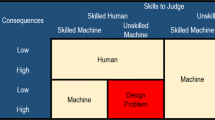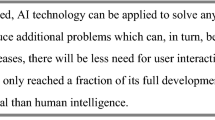Abstract
When designing an Agent-Based Simulation Model a central challenge is to formulate the appropriate interactions between agents as well as between agents and their environment. In this contribution we present the idea of capturing agent-environment interactions based on the “affordance” concept. Originating in ecological psychology, affordances represent relations between environmental objects and potential actions that agents may perform using those objects. We assume that explicitly handling affordances based on semantic annotation of entities in simulated space may offer a higher abstraction level for dealing with potential interaction. Our approach has two elements: firstly a methodology for using the affordance concept to identify interactions and secondly a suggestion for integrating affordances into agents’ decision making. We illustrate our approach indicating an agent-based model of after-earthquake behavior.
Similar content being viewed by others
References
Awaad, I., Kretschmar, G., Hertzberg, J.: Finding ways to get the job done: an affordance-based approach. In: Twenty-Fourth International Conference on Automated Planning and Scheduling (ICAPS 2014), Portsmouth, USA, June 2014, pp. 499–503 (2014)
Bandini, S., Federici, M.L., Vizzari, G.: Situated cellular agents approach to crowd modeling and simulation. Cybern. Syst. 38(7), 729–753 (2007)
Brom, C., Lukavsky, J., Sery, O., Poch, T., Safrata, P.: Affordances and level-of detail AI for virtual humans. In: Proceedings of Game Set and Match 2 (2006)
Carrascosa, C., Klügl, F., Ricci, A., Boissier, O.: From physical to virtual: widening the perspective on multi-agent environments. In: Weyns, D., Michel, F. (eds.) Agent Environments for Multi-Agent Systems IV: 4th Int. Workshop, E4MAS 2014 - 10 Years Later, Paris, France, May, 2014, pp. 133–146 (2015)
Chemero, A.: An outline of a theory of affordances. Ecol. Psychol. 15(2), 181–195 (2003)
Cornwell, J.B., O’Brien, K., Silverman, B.G., Toth, J.A.: Affordance theory for improving the rapid generation, composability, and reusability of synthetic agents and objects (2003)
Epstein, J.M.: Generative Social Science: Studies in Agent-Based Computational Modeling. Princeton University Press (2007)
Gibson, J.J.: The Ecological Approach to Visual Perception. Houghton Mifflin (1979)
Heckel, F.W.P., Youngblood, G.M.: Contextual affordances for intelligent virtual characters. In: Proceedings of the IVA 2011, LNAI 6895, pp. 202–208 (2001)
Hermans, T., Rehg, J.M., Bobick, A.F.: Decoupling behavior, perception, and control for autonomous learning of affordances. In: IEEE International Conference on Robotics and Automation (ICRA), 2013, pp. 4989–4996 (2013)
Horton, T.E., Chakraborty, A., Amant, R.S.: Affordances for robots: a brief survey. AVANT (2012)
Jonietz, D., Timpf, S.: An affordance-based simulation framework for assessing spatial suitability. In: Proceedings of COSIT 2013, Spatial Information Theory (LNCS 8116), pp. 169–184 (2013)
Joo, J., Kim, N., Wysk, R.A., Rothrock, L., Son, Y.J., Oh, Y.G., Lee, S.: Agent-based simulation of affordance-based human behaviors in emergency evacuation. Simul. Model. Pract. Theory 13, 99–115 (2013)
Jordan, T., Raubal, M., Gartrell, B., Egenhöfer, M.J.: An affordance-based model of place in gis. In: Poiker, T., Chrisman, N. (eds.) Proceedings of 8th International Symposium on Spatial Data Handling, pp 98–109. CA, Vancouver (1998)
Kapadia, M., Singh, S., Hewlett, W., Faloutsos, P.: Egocentric affordance fields in pedestrian steering. In: Proceedings of the 2009 Symposium on Interactive 3D Graphics and Games (I3d ’09), pp 215–223. ACM, New York, NY, USA (2009)
Klügl, F.: Affordance-based interaction design for agent-based simulation models. In: Bulling, N. (ed.) Multi-Agent Systems: 12th Eur. Conference, EUMAS 2014, Prague, Czech Republic, Dec. 2014, Revised Selected Papers, pp 51–66. Springer, Cham (2015)
Klügl, F., Bazzan, A.L.C.: Agent-based modeling and simulation. AI Mag. 33(3), 29–40 (2012)
Klügl, F., Davidsson, P.: AMASON: abstract meta-model for agent-based simulation. In: Proceedings of MATES 2013, pp. 101–141. Springer, Berlin (LNAI8076) (2013)
Klügl, F., Oechslein, C., Puppe, F., Dornhaus, A.: Multi-agent modelling in comparison to standard modelling. Simulation News Europe 40, 3–9 (2004)
Koppula, H.S., Saxena, A.: Anticipating human activities using object affordances for reactive robotic response. In: Robotics: Science and Systems IX, Berlin, June 2013 (2013)
Ksontini, F., Mandiau, R., Guessoum, Z., Espié, S.: Affordance-based agent model for traffic simulation. Journal of Autonomous Agents and Multiagent Systems online first (2014)
Kubera, Y., Mathieu, P., Picault, S.: IODA: An interaction-oriented approach for multi-agent based simulations. Auton. Agent. Multi-Agent Syst. 23(3), 303–343 (2011)
Locatelli, M.P., Vizzari, G.: Awareness in collaborative ubiquitous environments: the multilayered multi-agent situated system approach. ACM Transactions on Autonomous and Adaptive Systems 2, 13.1–13.21 (2007)
Lopez y Lopez, F., Luck, M., d’Inverno, M.: A normative framework for agent-based systems. Computational and Mathematical Organization Theory 12(2–3), 227–250 (2006)
Maslow, A.H.: A theory of human motivation. Psychol. Rev. 50(4), 370–396 (1943)
Montesano, L., Lopes, M., Bernardino, A., Santos-Victor, J.: Learning object affordances: from sensory–motor coordination to imitation. IEEE Trans. Robot. 24(1), 15–26 (2008)
Murphy, R.R.: Case studies of applying Gibson’s ecological approach to mobile robotics. IEEE Trans. Syst. Man Cybern. Part A Syst. Humans 29(1), 105–111 (1999)
Norman, D.A.: The Invisible Computer. MIT Press (1999)
van Oijen, J., Vanhee, L., Dignum, F.: CIGA: a middleware for intelligent agents in virtual environments. In: Proceedings AEGS 2011, LNAI 7471, pp. 22–37. Springer (2012)
Ortmann, J., Kuhn, W.: Affordances as qualities. In: Galton, A., Mizoguchi, R. (eds.) Proceedings of the 2010 Conference on Formal Ontology in Information Systems (FOIS 2010), pp 117-130. IOS Press, The Netherlands (2010)
Papasimeon, M.: Modelling agent-environment interaction in multi-agent simulations with affordances. Ph.D. thesis, Melbourne School of Engineering University of Melbourne (2009)
Paris, S., Donikian, S.: Activity-driven populace: a cognitive approach to crowd simulation. IEEE Comput. Graph. Appl. 29(4), 34–43 (2009)
Raubal, M.: Ontology and epistemology for agent-based wayfinding simulation. Int. J. Geogr. Inf. Sci. 15, 653–665 (2001)
Raubal, M., Moratz, R.: A functional model for affordance-based agents. In: Rome, E., Hertzberg, J., Dorffner, G. (eds.) Towards Affordance-Based Robot Control, Lecture Notes in Computer Science, vol. 4760, pp. 91–105. Springer, Berlin, Heidelberg (2008)
Ricci, A., Piunti, M., Viroli, M.: Environment programming in multi-agent systems: an artifact-based perspective. Journal Autonomous Agents and Multi-Agent Systems 23, 158–192 (2011)
Şahin, E., Çakmak, M., Dogar, M.R., Ugur, E., Ücoluk, G.: To afford or not to afford: a new formalism of affordances towards affordance-based robot control. Adapt. Behav. 15(4), 447–472 (2007)
Schneider, S.: Grounding geographic information in perceptual operations, vol. 244. IOS Press (2012)
Shaw, R.: The agent-environment interface: Simon’s indirect or Gibson’s direct coupling. Ecol. Psychol. 15(1), 37–106 (2003)
Ugur, E., Şahin, E., Oztop, E.: Unsupervised Learning of Object Affordances for Planning in a Mobile Manipulation Platform. In: IEEE International Conference on Robotics and Automation (ICRA), 2011, pp. 4312–4317 (2011)
Weiss, G.: Multiagent Systems, 2nd edn. MIT Press (2013)
Weyns, D., Omicini, A., Odell, J.: Environment as a first class abstraction in multiagent systems. Auton. Agent. Multi-Agent Syst. 14(1), 5–30 (2007)
Wooldridge, M.J.: Introduction to Multiagent Systems, 2nd edn. Wiley (2009)
Author information
Authors and Affiliations
Corresponding author
Rights and permissions
About this article
Cite this article
Klügl, F. Using the affordance concept for model design in agent-based simulation. Ann Math Artif Intell 78, 21–44 (2016). https://doi.org/10.1007/s10472-016-9511-0
Published:
Issue Date:
DOI: https://doi.org/10.1007/s10472-016-9511-0




